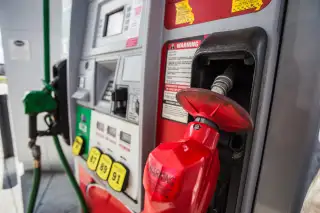The Russia-Ukraine Conflict Could Soon Send Gas Prices Even Higher

Let's hope you're not planning on taking a road trip anytime soon. Gas prices around the U.S. have risen for eight weeks in a row, and the cost of fueling up is only expected to get more expensive due to the Ukraine-Russia conflict.
As of Tuesday, the average price for a gallon of regular gasoline stood at $3.53 nationally, according to AAA. That's an increase of 21 cents over last month and a whopping 90 cents higher than at this time in 2021.
High gas prices have been hitting consumers' budgets for months. Back in October, prices at the pump reached what was then a seven-year high at an average of $3.27 per gallon, and they've only crept up since then.
Other kinds of gas and oil prices have been soaring as well, and the result has been abnormally high heating bills for people all over the country.
All of these price increases stem from the rising cost of energy — wholesale crude oil in particular. Brent crude oil, a benchmark for global prices, is moving closer to $100 per barrel this week. That's up from an average of roughly $87 in January and $75 in December, according to the federal U.S. Energy Information Administration (EIA).
Why are oil and gas prices so high?
Why are oil prices rising? There are many factors, but the gist is that the global supply of oil has failed to keep up with demand, which has been rising since the world slowly began reopening in the second half of 2020 after the most severe pandemic shutdowns ended.
More recently, tensions along the Russia-Ukraine border have pushed oil prices higher. As a Tuesday AAA post explains, the U.S. and allies have said they will enact sanctions against Russia if it invades Ukraine. If that happens, Russia could take steps to drive up oil prices further as a means of retaliation.
“Russia is one of the leading oil producers globally, behind only the United States and Saudi Arabia,” Andrew Gross, AAA spokesperson, said in the post. “And if they choose to withhold their oil from the global market, such a move would eventually be reflected in higher gas prices for American drivers.”
At a news conference Tuesday afternoon, President Joe Biden said he intended to make sure the U.S. economy wasn't harmed by sanctions on Russia, adding that he's "closely monitoring" energy supplies.
"We're executing the plan in coordination with major oil producing consumers and producers toward a collective investment to secure stability and global energy supplies. This will blunt gas prices," Biden said. "I want to limit the pain the American people are feeling at the gas pump."
Drivers had been led to believe that gas prices would be going in the opposite direction in early 2022. The EIA forecast that gas prices would decrease in January to roughly $3 a gallon, based on a parallel drop predicted for oil prices.
Quite obviously, that never happened.
Instead, gas has steadily become more expensive, and experts anticipate the pace could be about to pick up for fuel cost increases.
"The weeks ahead could be rather ugly with rising prices, especially if Russia pursues a strong-arm invasion of Ukraine,” Patrick De Haan, head of petroleum analysis for the GasBuddy app, said this week in a post noting that gas prices have already risen nationally for eight consecutive weeks.
Some industry analysts have speculated that oil prices will soon cruise past $100 a barrel and perhaps hit $120 in a worst-case scenario. The last time oil prices were anywhere near that mark was 2014, when the average gallon of gas often cost more than $3.70 around the country.